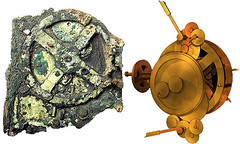
They concluded that the device contained 37 gears, about 30 of which still survive. It was originally housed in a wooden case slightly smaller than a shoebox.
Two dials on the front show the zodiac and a calendar of the days of the year that can be adjusted for leap years. Metal pointers show the positions in the zodiac of the sun, moon and five planets known in antiquity. Two spiral dials on the back show the cycles of the moon and predict eclipses.
The complicated meshing of the gears is a physical representation of the so-called Callippic and saros astronomical cycles. In the Callippic cycle, for example, the sun, moon and Earth return to the same relative orientations four times in 76 years minus one day.
The saros cycle predicts that, following a solar or lunar eclipse, a similar eclipse will occur 223 lunar months later.
By turning the gears with a hand crank, the user could select a specific day in the past or future and observe the positions of the heavenly objects on that day.
This is quite a sophisticated application of mechanical technology. Was the Antikythera mechanism the pinnacle of this technology, or did the Greeks push the boundaries ever further? Might accurate Greco orrerys be hiding in the wreckage of some other sunken ship as yet undiscovered? Some evidence suggest that the trade ship carrying the device originated in Rhodes, home of the famed ancient astronomer Hipparchus. The trade ship sank around 65 B.C., and researchers estimate the Antikythera mechanism was constructed sometime between 150-100 B.C. Since Hipparchus died around 120 B.C., the intriguing possibility that he was involved in its design is hard to avoid.
Dr. Charette noted that more than 1,000 years elapsed before instruments of such complexity are known to have re-emerged. A few artifacts and some Arabic texts suggest that simpler geared calendrical devices had existed, particularly in Baghdad around A.D. 900.
It seems clear, Dr. Charette said, that “much of the mind-boggling technological sophistication available in some parts of the Hellenistic and Greco-Roman world was simply not transmitted further,” adding, “The gear-wheel, in this case, had to be reinvented.”
I have to wonder how long it will be now before someone publishes an alternate history in which Hipparchus is cast as a Charles Babbage figure, and the Antikythera mechanism a forerunner of some Hellenic difference engine incarnation. What's the over/under on that? Since the two devices are purely mechanical, it seems the technological gulf between the two devices isn't nearly as wide as the two millennia separating them might suggest. What advances in Greek metalworking would be necessary for them to begin to approximate the design of Babbage's polynomial function tabulator?
1 comment:
Just for the record, Jayme, I was researching the Antykithera months ago, when I was formulating a device that was a compass, but more than a compass, with gears, for the new novel... Just for the record.
Post a Comment